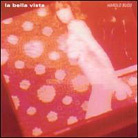February 2004
Budd’s partnership with Eno on two recordings, Plateaux of Mirror and The Pearl, brought him in contact with Daniel Lanois, who co-produced his newest recording, La Bella Vista. Lanois’ productions, like Eno’s, aim for atmosphere rather than sonic purity (e.g., Bob Dylan’s Time Out of Mind), but the ten tracks on La Bella Vista present Budd’s solo piano in a relatively straightforward manner. La Bella Vista strips Harold Budd’s music down to its essentials -- to his strong feel for melody, his pursuit of a beautiful line for its own sake, and his emotional openness. Lanois and co-producer Adam Samuels recorded the first five tracks secretly at a gathering in Lanois’ home. Budd performed in the presence of "…unexpected company," as Lanois describes in his liner notes, "intellectual, idealistic and beautiful females." Budd returned for another session in the same company on a later date. This description of the setting is meant, perhaps, to give us some idea of what stimulated the performances and it’s the only guidance we get, aside from the titles. I’ve surmised from comments Budd has made in liner notes for other releases that he takes great care in naming his works, so it may indeed be significant that such titles as "The Rose," "Her Face," "Bird Charmer," and "Other Flowers" suggest an exalted view of feminine beauty. That old-fashioned sentiment may be charming or anachronistic, depending on your point of view, and La Bella Vista reveals a composer who is more traditional than one might assume. While these pieces are spontaneous, they result from years of years of playing and writing, and we recognize immediately Budd’s talent for finding beautiful melodies. Budd’s work has often been assisted or doctored by modern technology -- many of his pieces rely on electronic keyboards, processed piano, and other effects to establish a mood or sound. Hearing him play on acoustic piano, we can observe how indebted he is to French Impressionist composers, particularly Erik Satie (whom Lanois names in the liner notes). These improvised compositions use a simple chord or arpeggio as a foundation, over which Budd plays exquisite melodies. They share the meditative quality that is characteristic of much of his work, but the acoustic piano seems to open him up emotionally -- he allows himself more freedom to express himself than he sometimes does in the ambient pieces. Lanois asserts that "Adam Samuels flawlessly records every note" on La Bella Vista. Not so, I’m afraid. The piano may be too closely miked or Lanois and Samuels may have altered the recording in some way, but I felt that notes were sustaining too long and blending into each other rather than ringing out. Still, the overall feel of the recording is warm and enveloping, and it was only when I listened to a disc of a cleanly recorded piano (Satie: Piano Music [Sony Classical/Legacy SBK 87280]) that I confirmed my suspicion about the sound of La Bella Vista. Budd played the pieces on Lanois’ piano, "…my restored turn-of-the-century Steinway," and the instrument does have a wonderfully inviting tone. I hope Harold Budd does more solo piano recordings. As much as I like the several works I own by him, only By the Dawn’s Early Light shows as much feeling as Budd expresses in these pieces. I’d like to hear what he’d do with music from his other recordings. I suspect that underneath the sometimes antiseptic beauty of those discs lies a deep well of emotion. GO BACK TO: |
 Harold Budd - La
Bella Vista
Harold Budd - La
Bella Vista Minimalist composer
Harold Budd’s collaborations with rock musicians, such as the Cocteau Twins’
Robin Guthrie and XTC’s Andy Partridge, have probably brought him to the attention of
more listeners than some of his contemporaries. In 1976, Budd began an association with
another highly experimental rock musician, Brian Eno, whose wide-ranging interests
included minimalist and ambient music. Eno produced his second recording, The Pavilion
of Dreams (1978), and released what many consider to be Budd’s best work, The
White Arcades (1988), on his own label, Opal Records.
Minimalist composer
Harold Budd’s collaborations with rock musicians, such as the Cocteau Twins’
Robin Guthrie and XTC’s Andy Partridge, have probably brought him to the attention of
more listeners than some of his contemporaries. In 1976, Budd began an association with
another highly experimental rock musician, Brian Eno, whose wide-ranging interests
included minimalist and ambient music. Eno produced his second recording, The Pavilion
of Dreams (1978), and released what many consider to be Budd’s best work, The
White Arcades (1988), on his own label, Opal Records.